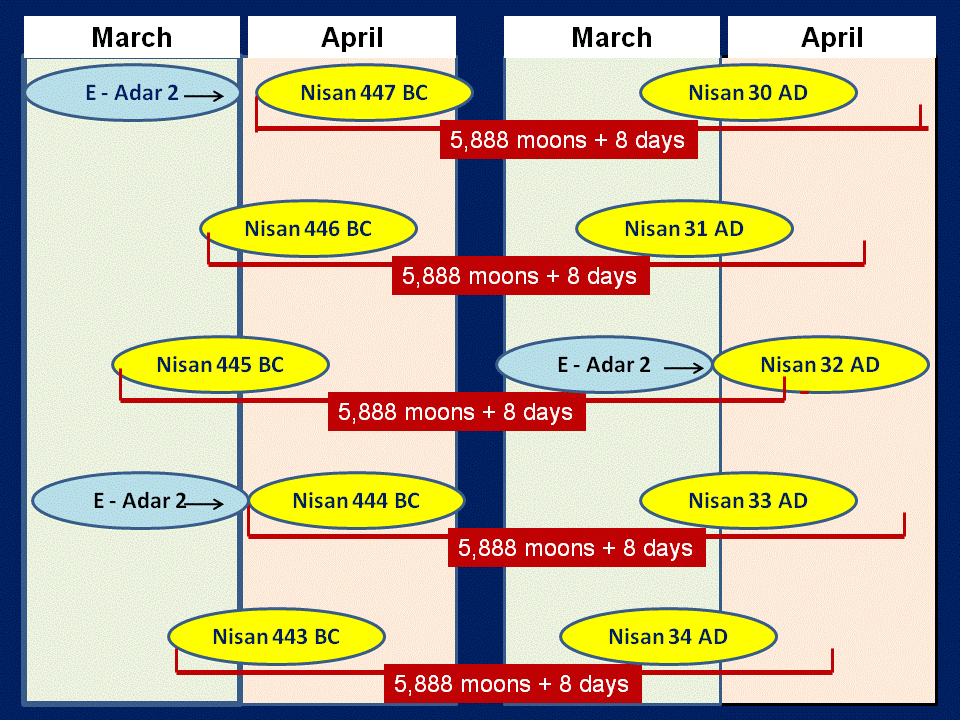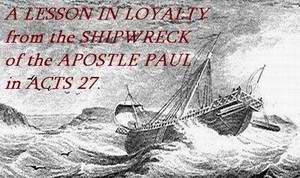32 A.D. WAS THE CRUCIFIXION YEAR


32 A.D. WAS THE CRUCIFIXION YEAR


By Gavin Finley M.D. - endtimepilgrim.org
32 A.D., AN EMBOLISMAL YEAR, IS THE ONLY YEAR THAT HAS A LATE NISAN MOON TO ALLOW THE 173,880 DAYS TO CONNECT THE NISAN MOON OF NEHEMIAH WITH THE NISAN MOON OF THE CRUCIFIXION YEAR.
From the chart above we can see that our 173,880 day time-span is nearly a month longer than the 476 years as measured from equinox to equinox. This is a very long timespan and it must begin in the Passover month of Nisan in Nehemiah's time and terminate in the month of Nisan in the crucifixion year. We can see that only a late Nisan in the year of the cross as provided by an embolismal year, (a year in which an extra month of Adar has been inserted), will accommodate this extra length. Passover, being pushed up later up into the year allows for this extra length of 24 days over the year.Here are the facts of the matter. Only the yeear 32 A.D fits the bill. Timespans terminating in 30 A.D., 31 A.D., 33 A.D. or 34 A.D. just won't cut it. Time-spans ending in 31 A.D. and 33 A.D. land in Nisan months that occur too early in the year to fit the 173,880 days. And the time lines beginning in 446 B.C. and 444 B.C., (the latter favored by Professor Hoehner and others), actually begin in embolismal years. So they start late. These make for 476 year Nisan to Nisan time lines that are too short to fit. They are lot long enough to fit in the required number of days for the 69 weeks(sevens) of years. Time spans other than the time span which terminates in 32 A.D. simply cannot accommodate this long 173,880 day period which overflows 25 days beyond the 476 years.
We can see that only the time span #2, beginning in the year 445 B.C. and terminating in 32 A.D. will fit. This is the time span advanced by Sir Robert Anderson in his classic work, 'The Coming Prince'. Only this time-line will succeed in connecting into two Nisan moons, the beginning Nisan moon being the Nisan of Nehemiah and the ending Nisan moon being the Nisan of the Passover of our Lord's crucifixion.
Here are the details. A true and correct time span of the Seventy Weeks of Daniel will lay out the first 69 weeks bridging two auspicious dates in holy history according to the scriptures. The 69 weeks (or sevens) are 69 x 360 = 173,880 days. The time span of 173,880 days is close to an even number of years but not exactly. It is 476 years plus 25 days. And yet he 173,880 days must link the Nisan moon of Nehemiah chapter 2 to Nisan 10, Palm Sunday, in the Nisan Passover moon of the crucifixion year. This time span of 173,880 days is 476 years plus that long and lanky extra 25 days. Dear saints. This is very important! When we come to connect our 476 years and 25 days into two Nisan moons 476 years apart we need to do our homework properly. We need to set out our Nisan moons, as we have done up above. Then we need to ask the question.
Does the time line fit?!"These extra 25 days over the year quite clearly make for a rather stretchy task. We must fit this long time line between Nisan months of year 'A' for Nehemiah with a point day ten days into the terminus Nisan moon for Passover, the Nisan month of year 'B'. When we stop and take a long hard look at the situation we realize that in order to fit the time line Year 'B' simply must be a late embolismal Passover Nisan moon. It has to be a late Passover in order to make that long and lanky time line fit into the two Nisan moons 476 years apart.
As can be seen from the diagram the 31 A.D. and 33 A.D. terminus dates fail here. They simply do not fit the bill. Only 32 A.D. was a year with such a late Passover. 32 A.D. was an embolismal year in which an extra month of Adar was inserted in the early spring. Embolisms occur seven times every 19 years in a cadence known as the metatonic cycle. So the Passover month of Nisan was a late one for 32 A.D.. That is why it fits the bill for Passover and 33 A.D. does not. In addition to that, Nisan of 445 B.C., (-444 A.D.) was the 20th year of Artaxerxes Longimanus. When we add 476 years to -444 A.D. it brings us to 32 A.D. the correct year and an embolismal year with a late Passover. Only this year fits the bill.
When attempts are made to terminate the 173,880 day time span into the adjoining years 30 A.D. or 31 A.D or 33 A.D. or 34 A.D., the years before and after 32 A.D. these time lines just will not do. Only when the terminus of the 173,880 day time line is placed to terminate in 32 A.D. will the 173,880 days fit into two Nisan moons 476 years apart. It seems that the lunar cycles have been neglected by Biblical scholars and investigators. They have concentrated on identifying years and Hebrew date connections only to translate them into our Roman solar calendar. They measure the time line by the sun. But God has given us two heavenly bodies for calculating time. The lunar cycles are the key here. And we seem to have forgotten them. And remember that God said that both the sun and the moon have been given for the determination of times and seasons.
The reason the time line terminating in 32 A.D. fits the requirement is simple. 32 A.D. was an embolismal year. The 2 years before and after 32 A.D. were not embolismal years. So their Nisan to Nisan time spans of 5,887 moons fail to fit 173,880 days The Passover month came late in 32 A.D. making it 5,888 moons. The extra moon allowed the extra days to be fitted in.
Both the beginning and the end of the time span must abut into Nisan events. The Holy Scriptures absolutely and unequivocally require that the 69 weeks, or 173,880 days, fit neatly between the edict of Nehemiah, (which we are told in Nehemiah chapter 2 was in the month of Nisan), and Palm Sunday, (which was also in the Passover month of Nisan, Nisan 10). If we are running a time line 25 days over the 476 years then our Paschal Nisan connection, (Palm Sunday), simply must be a late Nisan. It must have been an embolismal year.
Did 32 A.D. see a Hebrew calendar with an extra month of Adar inserted in the early spring and pushing the month of Nisan further up in the year? Was 32 A.D. an embolismal year?
It certainly was!THE 444 B.C. TO 33 A.D. TIMELINE OF DR. HOEHNER FAILS
Let us look now at the third time span offered by Dr. Harold Hoehner. He suggests that the 173,880 day timelime terminated in Nisan of 33 A.D.. But as we see from the graphic above, 33 A.D. was not an embolismal year. If the time span terminated in 33 A.D. it would have terminated in a early Nisan moon. Therefore, going back 476 years and 25 days we push the beginning of the time span back to a day which is very early in the spring of 444 B.C.. As we can see it is over 15 days before the spring equinox Such a time line, beginning in 444 B.C. would come to full moon status very early and before the spring equinox. So it would not even be a Nisan month. That moon would be too early to qualify as Nisan. It would actually be the 12th month, the month of Adar.
TO ACCOMMODATE THE FULL 173,880 DAYS OF THE 69 WEEKSAs we see in the diagram above, the new moon of this particular month would have occurred in the early hours of March 2nd. This particular moon would have become a full moon 14 days later on March 16. So this 13th month coming in the early springtime would have reached its fullness on March 16. Therefore that moon would have fallen short of the spring equinox 'E' (which is March 21), by 5 days. A short-fall of this magnitude would clearly disqualify this moon as a candidate for the Nisan moon that year. It would therefore have been inserted as a 13th embolismal month in the Hebrew Calendar for that year and named as such as the second month of Adar or Adar 2.
So we must conclude that Professor Hoehner in his 444 B.C. to 33 A.D. has failed to connect his 173,880 day time line to the Nisan moon as Nehemiah specifies. Instead, connecting into an embolismal year for the start rather than an embolismal year at the finish he has actually connected it into the moon before the true Nisan, the month of Adar 2.
There is no way Nehemiah would have misjudged and called the month of Adar 2 the month of Nisan. He would surely have recognized that this moon beginning on March 2nd would have had to be declared the month of Adar 2 and not the month of Nisan. The rabbis, or any careful observer of the passages of the equinoxes and the new moons, would never have made a mistake of this gross a magnitude.
Here is another consideration. The Bible was written under the oversight of the Holy Spirit. The Holy Spirit never makes mistakes. And there us no way the Holy Spirit would have allowed such a mistake in the Hebrew calendar to be written into the Holy Scriptures.
So the Bible and the astronomical data have spoken. The 173,880 day time line 444 B.C. to 33 A.D. for the 69 weeks of Daniel falls short. It just fails to fit the facts. It fails to match the measuring line set by the astronomical courses of the sun and moon in the heavens.
As we have seen, 444 B.C. could not have been the year that Nehemiah went to the King. And 33 A.D. was not the year of the passion of Jesus. This long and lanky time span of 476 solar years and those extra 25 days does not connect into both Nisan moons for the years in question. Clearly the time span 444 B.C. to 33 A.D. is one year too late. Only the time line 445 B.C. to 32 A.D. fits the facts.
This is also confirmed by other scriptural evidence. History gives us plenty of evidence that the '20th year of Artaxerxes' Longimanus mentioned in Nehemiah 2 was in fact 445 B.C. And as we shall see below, the record of Dr. Luke in Luke 2 points clearly to Jesus ministry beginning in the fall of 28 A.D. His crucifixion would have occurred 3.5 years later during the Passover of 32 A.D..
FROM THE GOSPEL OF LUKE WE HAVE FURTHER EVIDENCE THAT THE CRUCIFIXION YEAR WAS 32 A.D. LUKE RECORDS THAT THE YEAR IN WHICH JOHN THE BAPTIST BEGAN HIS MINISTRY (AND THUS THE YEAR WHEN JESUS WAS BAPTIZED AND BEGAN HIS MINISTRY) WAS THE 15TH YEAR OF THE REIGN OF TIBERIUS CAESAR.
To find out when Jesus began His ministry we need only look up two things. First we find out which year of the reign of Tiberius saw John the Baptist begin his ministry. That was the year Jesus was baptized and the year He began His ministry. From the passage below from Luke chapter 3 we see it was the 15th year of Tiberiusís reign when John the Baptist began his ministry, preaching and baptising in the Jordan valley. Here is our scripture.LUKE 3:1-3The second thing we need to nail down is what year Tiberius began his reign. This is a well known, well established, and well documented year and season In fact we even know the actual Julian date. A quick check of Google or the encyclopedia tells us that the first year of Tiberius Caesar began on the 19th of August in 14 A.D. Here below, are just two of many available references giving the date for the commencement of Tiberius's reign.1. Now in the fifteenth year of the reign of Tiberius Caesar, Pontius Pilate being governor of Judea, Herod being tetrarch of Galilee, his brother Philip tetrarch of Iturea and the region of Trachonitis, and Lysanias tetrarch of Abilene,
(Luke 3:1-3)
2. while Annas and Caiaphas were high priests, the word of God came to John the son of Zacharias in the wilderness.
3. And he went into all the region around the Jordan, preaching a baptism of repentance for the remission of sins,
It was August 19, 14 A.D.Reference #1 and Reference #2.
Since the first year of Tiberius was after August 19, 14 A.D. then the fifteenth year of Tiberius was 14 years later and began on August 19 of 14 + 14 = 28 A.D.. So Jesus began His ministry in 28 A.D. in the fall of the year. Since we know from the Gospel accounts that Jesus saw four Passovers during his ministry of 3.5 years then the first Passover was in the following spring of 29 A.D.. The second was 30 A.D., the third was 31 A.D., and the fourth and final Passover, the passover of His crucifixion, was 32 A.D.
This fits perfectly with the calculation of the first 69 weeks of the 70 weeks prophecy as laid out by Sir Robert Anderson. Jesus as 'Messiah the Prince' came into Jerusalem on the 10th of Nisan in the spring of 32 A.D.
Back to Section 10
A WORD OF EXHORTATION TO THOSE
ENTERING THE 70TH WEEK
Back to Section 1
INTRODUCTION TO DANIEL'S
PROPHECY OF THE 70 WEEKS


Some more devotional articles on apocalyptic Biblical themes for the enquiring Christian.




